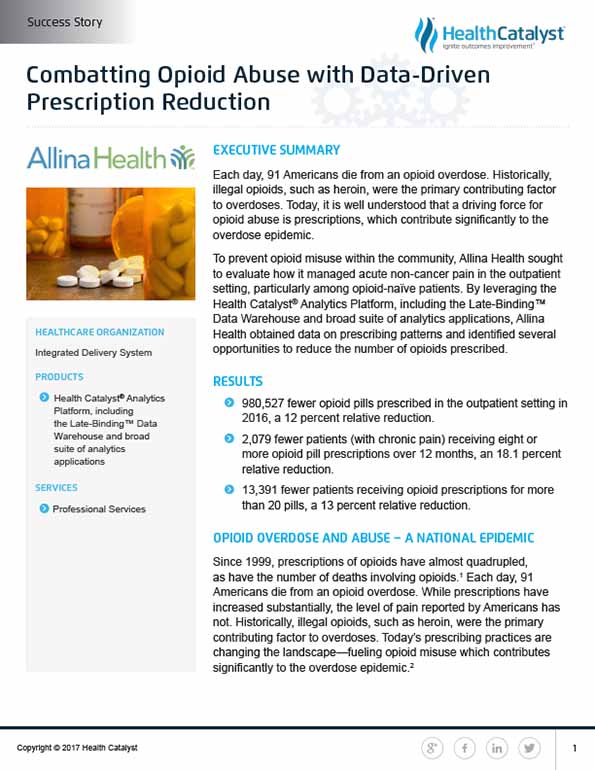Ninety-one Americans die from opioid overdoses every day, mostly due to the misuse of prescription medications. Following a series of adverse outcomes related to opioid misuse within the community, Allina Health evaluated its management of acute non-cancer pain for opioid-naïve patients, using analytics to identify opportunities to reduce opioid prescriptions.
Each day, 91 Americans die from an opioid overdose. Historically, illegal opioids, such as heroin, were the primary contributing factor to overdoses. Today, it is well understood that a driving force for opioid abuse is prescriptions, which contribute significantly to the overdose epidemic.
To prevent opioid misuse within the community, Allina Health sought to evaluate how it managed acute non-cancer pain in the outpatient setting, particularly among opioid-naïve patients. By leveraging the Health Catalyst Analytics Platform, including the Late-Binding™ Data Warehouse and broad suite of analytics applications, Allina Health obtained data on prescribing patterns and identified several opportunities to reduce the number of opioids prescribed.
Since 1999, prescriptions of opioids have almost quadrupled, as have the number of deaths involving opioids.1 Each day, 91 Americans die from an opioid overdose. While prescriptions have increased substantially, the level of pain reported by Americans has not. Historically, illegal opioids, such as heroin, were the primary contributing factor to overdoses. Today’s prescribing practices are changing the landscape—fueling opioid misuse which contributes significantly to the overdose epidemic.2
How prescriptions are written, the number of pills a patient receives, and the number that they subsequently take, all have a substantial impact on long-term opioid use. In a representative sample of opioid-naïve, cancer-free adults who received a prescription for opioids, the likelihood of chronic opioid use increased with each day the medication was used. After only one day of taking an opioid, patients had a 6 percent risk of still taking the medication a year later. Further, patients who use opioids for eight days or more saw that risk double, and when patients took opioids for 31 days or more, the risk of still being on an opioid a year later increased to nearly 30 percent.3
Allina Health, an integrated delivery system serving patients throughout Minnesota and western Wisconsin, sees more than 4.5 million clinic visits annually, 1.45 million hospital outpatient admissions, and fills more than 983,000 retail pharmacy prescriptions annually. In Minnesota, the drug overdose death rate among state residents increased 11 percent from 2014 to 2015. Approximately half of the drug-related deaths were associated with prescription medications.4
To minimize excessive quantities of opioids remaining after care and thus prevent opioid misuse within the community, Allina recognized a need to evaluate how it managed acute non-cancer pain in the outpatient setting, particularly among opioid-naïve patients. Given the complexities associated with the effective management of pain, Allina needed to ensure they had in place adequate clinician engagement, standard processes and expectations for managing acute pain, and appropriate support mechanisms to help facilitate any potential changes in practice.
Data Drives New Opioid Prescribing Guidelines. Systemwide clinical guidelines are used to support Allina providers in evidence-based decision making, ensuring the care delivered reflects the most recent body of knowledge. These clinical guidelines are developed by a multidisciplinary panel of experts, and the guidelines must be based upon a systematic review of the latest literature. Allina’s expectation is that all clinical guidelines include a plan for monitoring adherence, as well a plan to review and modify them at least once every three years—with modifications incorporating new research evidence.
While a clinical guideline for acute pain management was already in place, there was a sense that it had not yet been adopted across the entire system. Perhaps more importantly, the present guideline was not resulting in a noticeable reduction in the number of opioids prescribed. In response, the acute pain committee was formed as an interdisciplinary team whose membership included clinicians, program directors, pharmacists, educators, and other leadership from across Allina. The committee’s purpose is to ensure appropriate, standardized management of acute pain, while working to prevent overuse, abuse, and addiction. The team is also tasked with implementing and monitoring adherence to the acute pain guideline and communicating changes to best practices as they arise.
To better understand the current state of acute pain treatment at Allina, the acute pain committee needed data on the prescribing patterns of physicians to identify potential opportunities for improvement. Additionally, the committee needed to establish future performance measures that could be used to evaluate the effectiveness of any improvement efforts.
Allina relies on the Health Catalyst Analytics Platform, including the Late-Binding™ Data Warehouse and broad suite of analytics applications, as its primary source for managing and mining data. Using the Health Catalyst Analytics Platform, data analysts at Allina obtained data on prescribing patterns for the acute pain committee to review, including data for specific medications, differences in prescribing patterns between and among specialties, and data on the prescribing practices of each provider.
Following the review of the data, the committee identified opportunities to reduce the number of patients prescribed more than 20 pills in one prescription for acute pain. By reducing these prescriptions, the number of patients taking opioids and the number of days those opioids are taken would both be reduced—lowering the risk of long-term use or abuse and reducing the potential for opioids being diverted into the community.
The acute pain committee developed a comprehensive guideline for the appropriate use of opioids at Allina including best practices for prescribing opioids, and established requirements for opioid management throughout the health system. The guidelines include:
In addition to the acute pain committee’s work to promote progress and physician alignment, a goal specific to controlled substance monitoring was added to the Primary Care Service Line goals that all providers are accountable for achieving. Aware that one factor contributing to variability in prescribing opioids for the management of chronic pain was the quality and consistency of up-to-date education; all providers were required to complete a newly developed education program. In addition to structured education, much of the learning occurred through peer-to-peer presentations and informal discussions among providers at medical staff meetings.
To support providers in completing the workflow outlined in the new guidelines, Allina revised their EHR, developing a structured order set and progress note to aid in adherence to the systemwide chronic pain management guideline and improve the quality of care. In this order set, a provider has all the tools needed to guide them in the proper protocol for prescribing opioids, including access to the PMP, a link to the Allina guideline, risk assessment tools, a calculator for confirming appropriate opiate dosage, and a link to the Minnesota Board of Medical Practice pain management guidelines.
Encouraging Change in Patients. While providers were asked to change their prescribing practices, patients also had to change. Many providers at Allina were concerned that patients would feel less satisfied with their care as a result. Providers and care team members needed to have conversations with their patients, setting clear expectations and encouraging shared decision making on the best approach for managing pain, including possible alternative treatment, such as acupuncture, massage, and non-opioid medication.
Education materials were developed to enable providers and care team members to have effective conversations with their patients. Providers were also given talking points for common patient questions related to the comprehensive urine drug screen that is required of patients who are prescribed opioids. The controlled substance committee actively solicits feedback from providers and follows up on their concerns. When providers expressed concern regarding the cost to the patient for the urine drug screen, Allina obtained a lower cost test that provided the same quality results.
The analytics platform is used to monitor progress toward the controlled substance prescribing goals, including individual provider performance. An outlier report helps Allina identify when additional investigation and discussion is needed. When a provider is more than two standard deviations above the mean, the medical director and physician leaders reach out to the provider to discuss the data and evaluate the situation.
In just one year, Allina’s interdisciplinary approach to implementing evidence-based pain management and opioid prescribing guidelines, and commitment to alleviating pain without overuse of opioids, is achieving the desired results, including:
Allina has been successful in decreasing the total number of opioids prescribed while maintaining high patient satisfaction ratings. Among providers, the sharing of success stories is helping to increase understanding of the importance of following the evidence-based acute pain management guidelines. Since the guideline was introduced, several interesting incidents have occurred, including:
“Our analytics showed we had substantial variation in the number of pills prescribed for like-type procedures. We’ve been able to use evidence-based medicine to improve our approach to pain management, reducing the total number of opioids prescribed, and the risk associated with those opioids.”
– Keith Olson, DO, MHA, FACHE, Regional Medical Director, Allina Health
While gratified with the results of their opioid reduction work, the acute pain committee knows there is more work to be done. Next, the team will focus on standardizing pain management and prescriptions provided for specific procedures, ensuring a patient-specific approach across the continuum of care including: standardized instructions for how many pills a patient should take each day and how/when they should begin tapering off the opioids; and, a shared decision making tool for patients when considering the options for the treatment of pain. Committee members are aware that there will always be unique patient needs that will result in the need for appropriate variation, but they would like prescriptions to become more consistent.
Allina is also integrating prescribing data into the peer-review process. Soon, all providers will be able to see their individual data and the prescribing data of their peers, allowing for a review by comparison.




